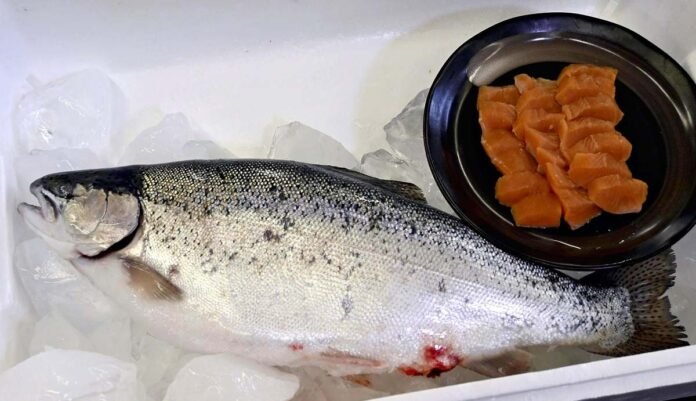Rainbow trout harvested in Kushiro Harbor last November
14:28 JST, May 22, 2024
SAPPORO – Steps are being taken across Japan to use salmon farms to address potential shortages resulting from recent poor autumn salmon catches.
The country’s more than 120 salmon farms have created fierce regional competition.
In eastern Hokkaido, cold ocean temperatures should provide fishermen with salmon catches after shipments of Honshu salmon dried up. However, the recent warming of the oceans in recent years has presented unexpected obstacles.
Fish farming
In November last year, the first catch of experimentally farmed rainbow trout was spotted in Kushiro Harbor in Hokkaido. A council made up of Kushiro City, a fishing association, a research institute and others named the fish Kushiro Akane Salmon in hopes of giving the fish its own brand.
Behind the expansion of salmon farming across the country lies a decline in catches of important fish species. The number of fall salmon returning to the country’s coasts and rivers in the 2023 financial year stood at 22.85 million, a quarter of the peak of 88.79 million in the 1996 financial year, according to the Japan Fisheries Research and Education Agency.
“The days when good catches go to those who just wait are a thing of the past. Fish farming is becoming increasingly important,” said Shigeki Himori, 70, chairman of the council.

In November last year, a farmed rainbow trout was spotted in Kushiro Harbour.
Rising water temperatures
Farmed salmon is fatty and makes good sashimi. In addition to the global fish-eating boom, growing demand for salmon in Japan and abroad at conveyor belt sushi restaurants is another reason why fish farming is booming in several regions.
The number of marine and land-based salmon farms in Japan reached 126 in April, more than double the 54 in December 2015, according to a survey by Satoshi Imai, a researcher at the agency’s Miyako office in Iwate Prefecture.
According to the Hokkaido Prefectural Government, serious moves to introduce salmon farming in the southern and eastern parts of Hokkaido began around 2019. Salmon, which prefer relatively cold water temperatures of 8 to 20 C, are caught in western Japan in spring and along the Sanriku coast of the Tohoku region until summer.
In the eastern part of Hokkaido, where the cold Oyashio Current flows, the hope was that salmon could be farmed in large enough numbers to be shipped until the fall, when the supply of salmon from Honshu diminishes, so that Hokkaido salmon by can be sold at high prices. .
However, the maximum water temperature in Kushiro Harbor rose to 23.9 C in the summer of 2023, well above the optimal temperature, resulting in fish growth failure. Only 2,086 of the 5,600 fish in aquariums were harvested.
The increase in water temperature is believed to have been caused by the northward movement of the warm Kuroshio Current and the ocean heat wave that followed the withdrawal of the Oyashio Current, a phenomenon that has occurred frequently off the east coast in recent years from Hokkaido.
Regional color
To address the situation, the municipality will take corrective measures when they attempt to farm rainbow trout in Kushiro Harbor again in the 2024 financial year. Their young fish will be grown to 800 grams, about twice the size of the previous year, and moved to tanks once they are strong enough to withstand the high water temperatures.
Tetsuya Yamazaki, director of the Mariculture Fisheries Research Institute of the Hokkaido Research Organization in Muroran, Hokkaido, said it is important to create added value in the sale of Hokkaido salmon because competitive prices are expected to increase with farmed salmon from other regions in Japan and imported salmon. The institute has provided advice on cultivation techniques and cost-saving measures for the branding of Kushiro Akane Salmon and other marine products.
Efforts have also been made in several areas to add regional colour, for example by mixing citrus fruits into fish food. “Success in this competitive environment depends on offering salmon that is unique to your region,” Yamazaki said.



